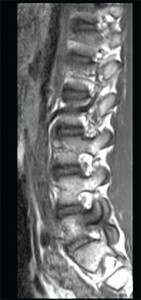
This sagittal T1 weighted MRI image of the lumbar spine shows spondylosis and bone marrowedema within the L5 pedicle extending into the articular facets and lamina.
Imae Credit: Living Art Enterprises/sciencesource.com
ROME, Italy—The explosion of imaging technology has made it more important than ever to establish a standardized way in which imaging can and should be used in clinical practice, an expert said in a session at EULAR 2015, the annual congress of the European League Against Rheumatism (EULAR).
Marie-Antonietta d’Agostino, MD, PhD, professor of rheumatology at the University of Paris, said clinicians now face a staggering array of choices and need guidance. “If you look at the number of imaging techniques that we can use today for our patient management, it’s completely crazy,” she said.
Using an imaging modality in data practice is a balancing act between improvement in outcomes and safety, feasibility and cost. Then there’s the issue of using imaging as an outcome measure, which involves identifying what is to be imaged, the appropriate instrument for assessing that imaging domain and how to use the imaging technique to serve the purpose.
Ideally, the use of imaging in clinical practice should dovetail with its value as an outcomes measure to make it more useful as a research tool, Dr. d’Agostino said.
How to Use Imaging
A EULAR task force on which she sat made recommendations last year describing how imaging should fit into clinical practice—for example, recommending computed radiography, magnetic resonance imaging and ultrasound be used in cases where there is doubt about diagnosis, and indicating that ultrasound and MRI are better than clinical evaluation when it comes to evaluating joint inflammation.1
However, Dr. d’Agostino said there are still some gaping needs in understanding the role of imaging.
More insight is needed, she said, on the importance of subclinical inflammation detectable only by imaging, including synovitis and bone marrow edema, especially when disease activity is low. A greater understanding is needed of the role of imaging in evaluating joint damage. Plus, she said, the feasibility, costs and training needed to use ultrasound and MRI in clinical practice need to be further assessed.
Use It to Guide Care
Paul Emery, MD, Arthritis Research UK Professor of Rheumatology at the University of Leeds, said that with all of the evidence regarding how imaging can help guide care, imaging is practically indispensable to the optimal practice of contemporary rheumatology.

